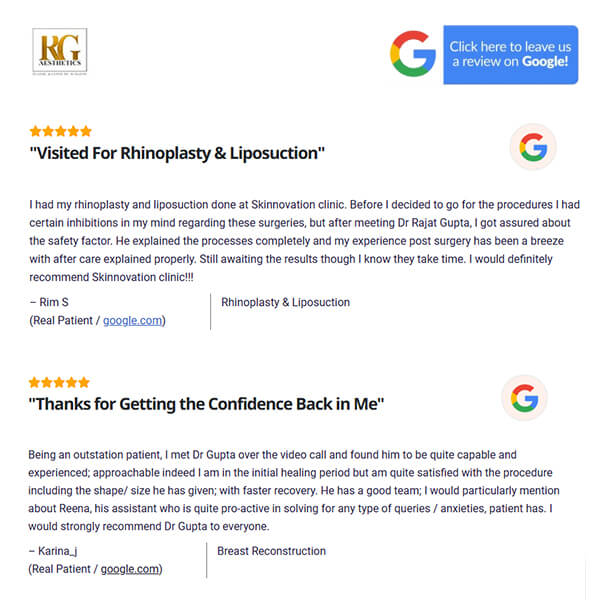Breast Reconstruction Surgery Techniques in Delhi
Breast reconstruction represents more than just physical rebuilding; it’s a pivotal step in healing and regaining control for those who have battled breast cancer or suffered any other kind of breast trauma. At RG Aesthetics, we understand that the decision to undergo reconstruction is profoundly personal and often filled with mixed emotions of fear and hope. Our dedicated team is here to support you through this emotional journey, offering not only advanced medical solutions but also emotional reassurance. We believe in empowering you to feel whole again, helping restore not just your physical appearance but also your inner strength and confidence.

Download A Patient Guidebook Of Breast Reconstruction ?
What is Breast Reconstruction?
Breast reconstruction is a surgical procedure aimed at restoring the shape and appearance of a breast following a mastectomy or breast injury. The primary goal of this surgery is to rebuild a breast that closely resembles the form and size of the original breast, thereby enhancing both the physical and psychological well-being of the patient. At RG Aesthetics, breast reconstruction is not just about aesthetics; it’s about helping patients reclaim their body image and self-esteem after a significant medical journey. It is a reassurance of a new life filled with body confidence and self-love.
Immediate vs. Delayed Reconstruction
After a mastectomy, breast reconstruction can be done either immediately or at a later time, depending on the patient’s medical condition and preferences.
Immediate Reconstruction: This type of reconstruction is performed during the same surgery as the mastectomy. One of its key benefits is that the patient wakes up with the breast shape already intact, reducing the psychological impact of the mastectomy. Additionally, it can reduce the number of surgeries needed and often leads to better aesthetic outcomes, as the skin and tissue are preserved during the mastectomy. However, for patients requiring post-mastectomy radiation, immediate reconstruction may not be the best option, as radiation can affect the healing process and compromise cosmetic results.
Delayed Reconstruction: In contrast, delayed reconstruction occurs months or even years after the mastectomy, typically once cancer treatments like chemotherapy or radiation are complete. This allows the patient to focus entirely on cancer treatment, reducing the risk of complications related to these therapies. Although waiting for reconstruction can be emotionally challenging for some, this approach offers greater flexibility in choosing the type of reconstruction and optimal timing. Both immediate and delayed reconstruction options have distinct advantages and should be carefully discussed with a healthcare provider to determine the best course of action.
Don’t take biggest decision of life
Without getting complete information!
Microvascular (Free Flap) Techniques for Breast Reconstruction
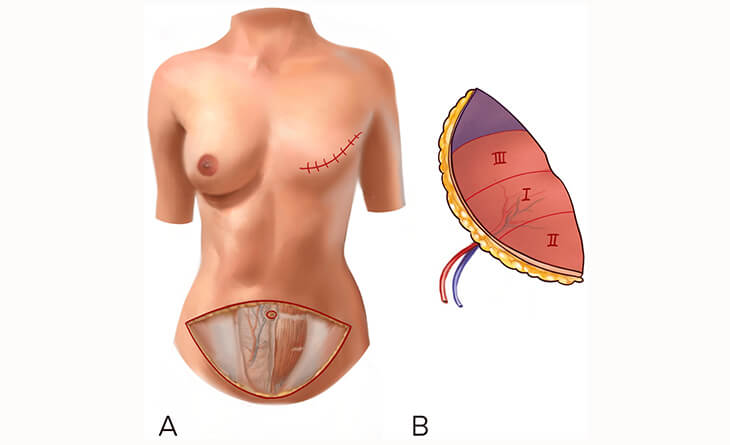
One of the advanced techniques we offer at RG Aesthetics is microvascular free flap surgery, which is highly regarded for its natural results and long-term benefits. In this procedure, tissue is transferred from one part of the body (such as the abdomen, thighs, or back) to reconstruct the breast. Unlike other reconstruction methods, the tissue is completely detached from its original location, and the surgeon uses microsurgical techniques to reconnect small blood vessels from the tissue to blood vessels in the chest.
This technique, which is done under a microscope, is more complex but offers significant advantages. Since the breast is reconstructed using the patient’s own tissue, the result is a more natural look and feel compared to implants. Common free flap procedures include the DIEP flap (deep inferior epigastric perforator) from the abdomen and the TUG flap (transverse upper gracilis) from the inner thigh. While these surgeries require specialised expertise, they typically provide long-lasting results and an excellent aesthetic outcome, particularly for patients who prefer a natural tissue reconstruction.
Nipple and Areola Reconstruction
For many patients, the final step of breast reconstruction involves creating a new nipple and areola, which can be important for restoring the appearance of the breast. At RG Aesthetics, nipple reconstruction is typically done after the main breast reconstruction has healed. Techniques for nipple reconstruction may involve small flap surgeries or medical tattooing, which is often used to recreate the colour and appearance of the areola. This final step can greatly enhance the symmetry and overall appearance of the reconstructed breast, helping patients feel whole again.
Types of Breast Reconstruction Techniques
At RG Aesthetics, we offer a variety of breast reconstruction techniques that can be tailored to meet the unique needs of each patient. Choosing the right technique depends on many factors, including the patient’s health, cancer treatment history, aesthetic goals, and personal preferences.
- Implant-Based Reconstruction
Implant-based reconstruction involves using saline or silicone implants to create a new breast shape. This method is generally less invasive than tissue-based reconstruction and is often recommended for patients who prefer a shorter recovery time or lack sufficient donor tissue for flap procedures. Implant-based reconstruction can be done in one of two ways:
- Direct-to-Implant Reconstruction: This method places the implant during the same surgery as the mastectomy, often with the help of an acellular dermal matrix (ADM), which supports the implant and helps achieve a natural-looking result.
- Two-Stage Reconstruction: In this method, a tissue expander is inserted during the mastectomy to gradually stretch the skin and chest muscles over several weeks. Once the skin has adequately expanded, a second surgery is performed to replace the expander with a permanent implant.
Advantages: Implant-based reconstruction generally requires less surgery time and recovery compared to flap procedures. Additionally, many patients prefer the predictability of implants for size and shape.
Disadvantages: Implants may not feel as natural as autologous tissue, and they carry the risk of complications such as capsular contracture, implant rupture, or infection. Some patients may also require replacement or revision surgery in the future.
- Autologous Tissue (Flap) Reconstruction
Autologous tissue reconstruction uses tissue from other parts of the patient’s body to recreate the breast. This technique can provide a more natural look and feel since the tissue behaves more like the patient’s own breast tissue.
The most common types of flap procedures include:
- DIEP Flap (Deep Inferior Epigastric Perforator): The DIEP flap uses skin and fat from the lower abdomen to reconstruct the breast without removing any muscle. This method preserves abdominal strength while still providing enough tissue for breast reconstruction. An added benefit of using abdominal tissue for breast reconstruction is that it doubles as an abdominoplasty. This means patients not only achieve complete breast reconstruction but also enjoy a slimmer, more toned abdomen—two advantages from a single surgery.
- TRAM Flap (Transverse Rectus Abdominis Myocutaneous): The TRAM flap also uses tissue from the abdomen, but in this procedure, the surgeon uses a portion of the rectus abdominis muscle along with the skin and fat. It’s a robust technique but may lead to more abdominal weakness post-surgery.
- TUG Flap (Transverse Upper Gracilis): The TUG flap uses tissue from the inner thigh, including a small muscle, to create a new breast mound. This option is often suitable for women who do not have enough abdominal tissue for a DIEP or TRAM flap.
- Latissimus Dorsi Flap: In this procedure, muscle, fat, and skin from the upper back are used to form a new breast. This technique is less common but may be used in combination with an implant for patients with limited donor tissue in other areas.
Advantages: Flap procedures tend to create a more natural look and feel. They also offer a permanent solution that doesn’t require maintenance or replacement, unlike implants.
Disadvantages: Flap reconstructions are more complex and require longer surgery times and recovery periods. They can also result in scars at the donor site and may involve a more complicated healing process.
Contralateral Summarization Procedures
To achieve a balanced and symmetrical appearance, contralateral symmetrization procedures can be performed on the opposite breast. These procedures help ensure that the reconstructed breast matches the natural breast in terms of size, shape, and position, contributing to a harmonious overall result. Two common symmetrization techniques are:
Mastopexy (Breast Lift)
Mastopexy is a surgical procedure designed to lift and reshape the natural breast to better align with the reconstructed breast.
- Procedure Overview: During a mastopexy, excess skin is removed, and the surrounding breast tissue is tightened to create a firmer, more uplifted appearance. The areola may also be resized and repositioned for a more symmetrical look.
- When to Consider Mastopexy: This technique is ideal for patients whose natural breasts has sagged over time due to ageing, weight fluctuations, or other factors. It can be done in conjunction with the initial reconstruction surgery or at a later stage, depending on the patient’s recovery and personal preferences.
- Advantages: Mastopexy enhances the overall aesthetic balance between the reconstructed and natural breast, providing a more youthful contour and a lifted appearance.
- Disadvantages: Recovery from a mastopexy typically involves swelling, bruising, and temporary discomfort. It may also leave scars, although these usually fade over time and are often concealed along the natural contours of the breast.
Breast Reduction
Breast reduction surgery, also known as reduction mammoplasty, removes excess breast tissue, fat, and skin from the natural breast to achieve symmetry with the reconstructed breast.
- Procedure Overview: The surgeon carefully reduces and reshapes the natural breast to match the size and shape of the reconstructed breast. The areola may also be adjusted to maintain proportionate positioning.
- When to Consider Breast Reduction: This option is suitable for patients with larger natural breasts who wish to achieve a more balanced, proportional appearance after reconstruction. It can be performed simultaneously with the reconstruction or as a separate procedure.
- Advantages: Breast reduction not only helps achieve aesthetic symmetry but can also relieve physical discomfort associated with larger breasts, such as back, neck, or shoulder pain. It also reduces the risk of skin irritation under the breastfold.
- Disadvantages: Like other breast surgeries, breast reduction requires a longer recovery period and may result in visible scars. However, these scars are usually well-hidden and fade over time.
Download A Patient Guidebook Of Breast Reconstruction ?
Combined Symmetrization Approach
In some cases, a combination of mastopexy and reduction may be recommended to achieve the best results. Our surgeons at RG Aesthetics conduct a comprehensive evaluation, considering the patient’s unique anatomy, personal goals, and overall health, to design a personalized symmetrization plan.
At RG Aesthetics, our experienced surgical team is dedicated to achieving optimal symmetry and natural-looking results. By using advanced techniques and precision planning, we ensure that patients not only regain their physical appearance but also boost their self-confidence and overall well-being.
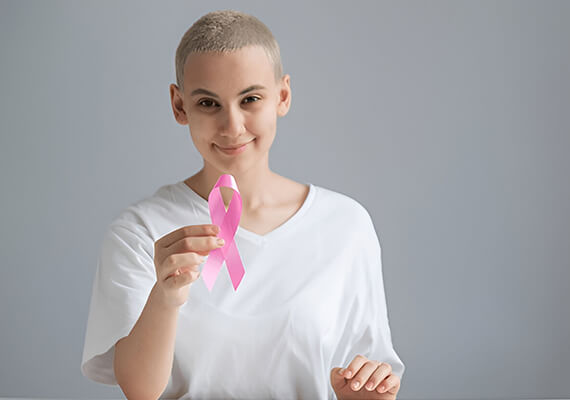
Complete Makeover: Tummy Tuck with Breast Reconstruction & Contralateral Rejuvenation
At RG Aesthetics, we understand that breast reconstruction is often part of a broader transformation journey. For patients seeking a more comprehensive change, we offer a complete makeover that combines breast reconstruction with a tummy tuck and contralateral breast rejuvenation to achieve a youthful, proportionate, and perky appearance.
Tummy Tuck (Abdominoplasty) with Breast Reconstruction
A tummy tuck, also known as abdominoplasty, is often performed alongside breast reconstruction, particularly with DIEP flap surgery. This approach utilizes skin and fat from the lower abdomen to recreate the breast, while simultaneously tightening the abdominal area for a slimmer and more toned midsection.
- Procedure Overview: During the tummy tuck, excess abdominal skin is removed, muscles are tightened, and the remaining skin is smoothed for a flatter stomach. The tissue removed during the tummy tuck can also be used for autologous breast reconstruction. This allows patients to achieve two significant aesthetic improvements in a single surgical session—restoring the breast and enhancing the abdominal contour.
- Advantages: Combining a tummy tuck with breast reconstruction provides a holistic transformation, improving both the upper and lower body contours. Patients benefit from enhanced body confidence, better-fitting clothes, and a more youthful silhouette.
- Disadvantages: As this is a more extensive surgery, the recovery period is longer compared to isolated procedures. Patients may experience swelling, discomfort, and limitations in physical activity during the initial healing phase. However, these effects are temporary and can be effectively managed with proper post-operative care.
Contralateral Rejuvenation: Achieving Perky, Youthful Breasts
To create a balanced and youthful breast appearance, contralateral rejuvenation is often performed along with breast reconstruction. This includes a breast lift (mastopexy) or breast reduction, adjusted to achieve a perky and youthful look that matches the newly reconstructed breast.
- Mastopexy (Breast Lift): As part of the rejuvenation, a breast lift can be performed on the natural breast to raise and reshape it, giving it a more lifted, youthful appearance. This procedure helps achieve symmetrical nipple positioning and a firmer breast contour that complements the reconstructed breast.
- Breast Reduction: For patients with larger natural breasts, a reduction can be performed to ensure the size and shape align with the newly reconstructed breast. This approach not only creates symmetry but also lifts and rejuvenates the breast for a perkier and more youthful result.
- Augmentation for Additional Volume: In some cases, patients may opt to include breast augmentation to add volume to either the reconstructed or natural breast, creating a fuller, more proportionate look.
Benefits of a Complete Makeover
- Holistic Transformation: A combined procedure addresses both breast and body contour, leading to a more proportionate, youthful figure.
- Convenience: By combining multiple procedures, patients can minimize their time in surgery, streamline recovery, and reduce overall downtime.
- Psychological Boost: A full-body makeover not only enhances physical appearance but also boosts self-esteem, helping patients feel rejuvenated and more confident in their own skin.
The Microvascular Approach: Free Flap Surgery
As mentioned earlier, free flap surgery is an advanced form of breast reconstruction that involves the transfer of tissue from one part of the body to the chest. This microvascular approach has revolutionized breast reconstruction, providing patients with long-lasting, natural-looking results.
The DIEP flap is one of the most popular forms of free flap surgery due to its ability to use abdominal tissue without sacrificing muscle, which helps maintain core strength. Similarly, the TUG flap offers excellent outcomes for women who may not have enough abdominal tissue but still desire a natural reconstruction.
One of the biggest advantages of free flap surgery is the use of the patient’s own tissue, which tends to age and change with the body, resulting in a more natural look over time. The microsurgical techniques used to reconnect blood vessels allow the transferred tissue to survive and function in its new location.
Free flap surgery requires significant expertise and a highly skilled surgical team. At RG Aesthetics, our experienced surgeons use state-of-the-art equipment to ensure the highest success rates and patient satisfaction.
Detailed Medical Procedure: Breast Reconstruction
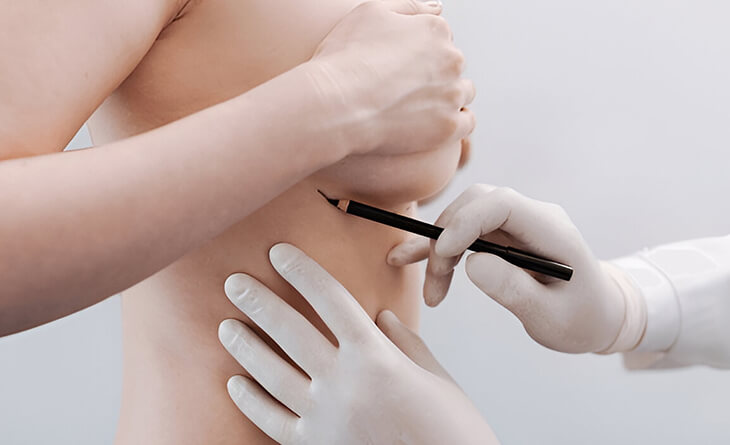
Breast reconstruction is a multi-step medical procedure that can be tailored to meet the specific needs of each patient. At RG Aesthetics, we prioritize patient safety and comfort throughout every phase of the reconstruction process, ensuring that patients are fully informed and prepared before, during, and after surgery.
- Pre-Operative Consultation and Planning
The first step in the breast reconstruction journey is a comprehensive consultation with your surgical team. During this consultation, your surgeon will review your medical history, assess your general health, and discuss your options for breast reconstruction based on your cancer treatment (if applicable), body type, and personal preferences. Your surgeon will also help you understand what to expect during the procedure and recovery process.
If you are undergoing a mastectomy, your breast surgeon and reconstructive surgeon will coordinate to plan the reconstruction surgery, whether it will be performed immediately or delayed. Pre-operative imaging, such as a CT scan or MRI, may be used to evaluate the chest and abdomen area and guide the reconstruction process.
Patients will also be given specific instructions to prepare for surgery, which may include adjusting medications, stopping smoking, and following a particular diet or exercise plan.
- The Day of Surgery: Preparing for the Procedure
On the day of surgery, patients are admitted to RG Aesthetics, where our surgical team will review the procedure and answer any last-minute questions. The medical team, including anesthesiologists, nurses, and surgeons, will ensure that the patient is comfortable and ready for surgery.
Anaesthesia:
Breast reconstruction is typically performed under general anaesthesia, meaning that the patient will be asleep throughout the entire procedure. The anaesthesia team will closely monitor the patient’s vital signs to ensure safety throughout the surgery.
- Surgical Procedure for Implant-Based Reconstruction
For patients undergoing implant-based reconstruction, the surgery typically follows these steps:
- Step 1: Tissue Expander (if two-stage reconstruction): If the patient is undergoing a two-stage implant-based reconstruction, the surgeon will first place a tissue expander beneath the chest muscle during the mastectomy. The expander gradually stretches the skin and muscle to create enough space for a permanent implant. This process takes several weeks, with saline being injected into the expander at regular intervals during follow-up visits.
- Step 2: Implant Placement: Once the tissue has expanded enough, the second stage of surgery involves removing the expander and placing the permanent saline or silicone implant. The surgeon will ensure that the implant is placed correctly to achieve the desired breast shape and size.
- Direct-to-Implant Option: In some cases, patients may opt for direct-to-implant reconstruction, where the permanent implant is placed immediately after the mastectomy. This technique eliminates the need for a tissue expander and can lead to a quicker overall recovery time. This is usually done for patients who are going for immediate breast reconstruction at the time of mastectomy and are not candidates for radiotherapy subsequently. This is also a viable option for prophylactic mastectomy, where the breast is removed to prevent the occurrence of cancer in genetically predisposed patients.
- Surgical Procedure for Autologous (Flap) Reconstruction
For patients choosing autologous tissue reconstruction, the procedure is more complex, involving the transfer of tissue from another part of the body to the chest to recreate the breast.
- Step 1: Tissue Harvesting: The surgeon will first identify the donor site, which is typically the abdomen (for DIEP or TRAM flaps), thighs (for TUG flaps), or back (for Latissimus Dorsi flaps). The necessary tissue, including skin, fat, and sometimes muscle, is carefully harvested.
- Step 2: Microvascular Free Flap Surgery: If the patient is undergoing microvascular free flap surgery (such as DIEP or TUG flaps), the harvested tissue is completely detached from the donor site. The surgeon will use specialized microsurgical techniques to reconnect the tiny blood vessels from the flap to the blood vessels in the chest. This is a delicate procedure that requires expertise in microsurgery to ensure the success of the tissue transfer.
- Step 3: Breast Mound Creation: Once the tissue has been successfully transplanted into the chest, the surgeon will carefully shape the tissue to create a natural-looking breast mound. The goal is to recreate a breast that is symmetrical and aesthetically pleasing while preserving as much sensation as possible.
- Nipple and Areola Reconstruction
After the breast mound has healed, patients can choose to undergo nipple and areola reconstruction. This is typically performed several months after the initial reconstruction surgery. Nipple reconstruction may involve creating a small flap of tissue on the reconstructed breast to form a nipple, while medical tattooing is used to recreate the appearance of the areola.
Tattooing is an effective way to simulate the natural colour and texture of the areola, and patients can customize the size, shape, and colour to match their preferences.
- Post-Operative Recovery: The Immediate Phase
Once the surgery is complete, patients are closely monitored in the recovery room. Most patients stay in the hospital for 2 to 4 days, depending on the type of reconstruction performed. During this time, the medical team will provide pain management, monitor vital signs, and ensure that there are no immediate complications such as bleeding or infection.
- Pain Management: Pain and discomfort are common after breast reconstruction surgery, particularly for flap procedures that involve multiple surgical sites. Patients will be given pain medications to manage discomfort, as well as instructions on how to care for their incisions and surgical drains.
- Wound Care: Surgical drains may be placed to help remove excess fluid from the surgical site, which helps prevent complications such as hematomas or seromas. Patients will be instructed on how to care for these drains, which are typically removed within 1 to 2 weeks after surgery.
- Long-Term Recovery and Follow-Up Care
Recovery from breast reconstruction can take several weeks to several months, depending on the type of reconstruction and the patient’s individual health. Most patients are able to return to light activities within 4 to 6 weeks, although full recovery may take longer for flap-based procedures.
- Follow-Up Appointments: Regular follow-up appointments are crucial to monitor healing and ensure the success of the reconstruction. During these appointments, the surgeon will check for signs of infection, monitor the health of the reconstructed breast, and assess the patient’s progress. Any concerns about scarring, asymmetry, or complications will be addressed during these visits.
- Physical Therapy: In some cases, physical therapy may be recommended to help patients regain strength and mobility, particularly if a flap procedure was performed. Physical therapy can help reduce stiffness in the chest and improve overall recovery.
- Lifestyle Adjustments: Patients are advised to avoid strenuous activities, heavy lifting, and vigorous exercise for several weeks after surgery. Wearing compression garments, as recommended by the surgeon, can help reduce swelling and support healing.
- Revisions and Refinements
While many patients achieve excellent results from their initial breast reconstruction surgery, some may require additional revision surgeries to refine the shape, address asymmetry, or correct minor complications. Revision surgery can involve adjusting the position of implants, reshaping the reconstructed breast, or improving the appearance of scars.
RG Aesthetics offers comprehensive revision options for patients who wish to further enhance the aesthetic outcome of their reconstruction.
Don’t take biggest decision of life
Without getting complete information!
Psychological and Emotional Considerations
Breast reconstruction is not just a physical transformation—it is often a deeply emotional journey. Women who have undergone mastectomy or trauma may feel a loss of identity or confidence. At RG Aesthetics, we recognize the emotional weight of breast reconstruction and strive to provide comprehensive support for each patient throughout the process.
The Psychological Benefits of Immediate Reconstruction
One of the key advantages of immediate reconstruction is the psychological benefit of waking up with a breast mound already in place. This can be immensely reassuring for patients, helping them avoid the emotional distress associated with a flat chest after mastectomy. Immediate reconstruction can give patients a sense of wholeness, boosting their confidence and helping them maintain a positive outlook during their recovery.
Support Groups and Emotional Guidance
We offer access to support groups where patients can share their experiences and connect with others who have faced similar challenges. Many patients find that speaking with others who have undergone breast reconstruction helps them feel less isolated and more empowered during their recovery.
Additionally, our team of healthcare professionals, including counsellors and patient advocates, is available to provide emotional support before, during, and after surgery. We believe that mental well-being is as important as physical healing, and we are committed to supporting every patient’s emotional health throughout their reconstruction journey.
Risks and Complications of Breast Reconstruction
Like any surgical procedure, breast reconstruction carries certain risks. At RG Aesthetics, we take every measure to minimise these risks through meticulous planning, state-of-the-art techniques, and ongoing post-operative care. However, it’s important for patients to be informed about potential complications before making a decision.
Common Risks Associated with Breast Reconstruction
- Infection: Infection can occur at the surgical site and may require additional treatment with antibiotics or, in rare cases, surgical intervention. Proper wound care and hygiene and close monitoring by our medical team help reduce the risk of infection.
- Bleeding and Hematoma: As with any surgery, there is a risk of bleeding during or after the procedure. Hematomas, or collections of blood under the skin, may also occur and require drainage.
- Implant Complications: For patients who choose implant-based reconstruction, there is a small risk of complications such as capsular contracture, where the scar tissue around the implant tightens and causes discomfort or alters the breast’s appearance. Implants can also rupture or leak over time, which may necessitate replacement surgery.
- Flap Complications: Flap procedures carry their own set of risks, including partial or complete loss of the flap if the blood supply is compromised. This is more common in patients with certain medical conditions, such as diabetes or smokers, who may have reduced circulation.
- Scarring: While every effort is made to minimise scarring, breast reconstruction will leave some scars, both on the breast and at the donor site, for flap procedures. Scars generally fade over time but will always be present to some degree. Patients should discuss their concerns with their surgeon, who can offer options for minimising scar visibility.
- Asymmetry: Achieving perfect symmetry between the reconstructed breast and the natural breast can be challenging. While every effort is made to create a balanced appearance, minor differences in size, shape, or position may occur.
- Delayed Healing: Some patients may experience slower healing due to factors such as age, smoking, or underlying health conditions. Delayed healing can increase the risk of infection and other complications and may prolong the recovery process.
How to Mitigate Risks
At RG Aesthetics, patient safety is our top priority. We take several steps to mitigate the risks associated with breast reconstruction:
- Pre-Surgical Evaluation: We conduct comprehensive health evaluations before surgery to ensure that patients are in optimal condition for surgery. This includes assessing any underlying medical conditions, reviewing the patient’s medications, and recommending lifestyle changes, such as quitting smoking, to improve surgical outcomes.
- Advanced Surgical Techniques: Our surgeons are highly skilled in using the latest surgical techniques to reduce the risk of complications. For example, during implant-based reconstruction, we use ADM (acellular dermal matrix) to support the implant and help reduce the risk of capsular contracture.
- Post-Operative Care: Following surgery, we provide detailed instructions for at-home care to promote healing and minimise the risk of infection or other complications. This includes guidelines for wound care, activity restrictions, and signs to watch for that may indicate a problem.
- Follow-up Appointments: Regular follow-up appointments are scheduled to monitor the patient’s progress, address any concerns, and ensure that the reconstructed breast is healing properly. These visits are crucial for catching potential issues early and addressing them promptly.
Download A Patient Guidebook Of Breast Reconstruction ?
Ideal Candidates for Breast Reconstruction
While breast reconstruction can be a life-changing procedure, it’s not suitable for everyone. Several factors must be considered to determine whether a patient is a good candidate for breast reconstruction.
- Physical Health
Patients must be in good overall health to undergo breast reconstruction. Conditions such as diabetes, heart disease, or autoimmune disorders can complicate the healing process and increase the risk of complications. Additionally, patients who smoke or have a history of blood clotting disorders may be at higher risk for complications during and after surgery.
- Timing of Reconstruction
As discussed earlier, breast reconstruction can be done immediately after a mastectomy or delayed until after other cancer treatments, such as chemotherapy or radiation, are complete. Patients must discuss the timing of reconstruction with their healthcare provider to determine the best approach based on their individual treatment plan and overall health.
- Realistic Expectations
It’s essential for patients to have realistic expectations about the results of breast reconstruction. While the goal is to create a breast that closely resembles the natural breast in size and shape, it may not be possible to achieve perfect symmetry or an exact match to the patient’s pre-mastectomy appearance. Patients should also understand that the reconstructed breast will not have the same sensation as a natural breast, although some sensations may return over time.
- Emotional Readiness
Breast reconstruction is a highly personal decision, and it’s important for patients to be emotionally prepared for the physical and emotional journey ahead. Some women may feel excited about the prospect of restoring their body image, while others may have mixed feelings about the procedure. At RG Aesthetics, we provide emotional support throughout the process, including access to counselling services and support groups for patients who need additional assistance in coping with the emotional aspects of reconstruction.
The Role of Nipple and Areola Reconstruction in the Process
As mentioned earlier, nipple and areola reconstruction is often the final step in breast reconstruction. This procedure is usually performed several months after the initial reconstruction, once the new breast mound has fully healed.
Areola Tattooing
At RG Aesthetics, we use medical tattooing to recreate the appearance of the areola, adding natural-looking colour and detail to the reconstructed breast. This technique can be customised to match the patient’s skin tone, ensuring that the new areola blends seamlessly with the surrounding skin.
Tattooing can be done in combination with nipple reconstruction or on its own if the patient does not wish to undergo further surgery. The tattoo is applied using special pigments designed for medical use, and the procedure is typically completed in a single session with minimal discomfort.
Breast Reconstruction Surgery Cost at RG Aesthetics
At RG Aesthetics, we understand that the cost of breast reconstruction surgery is a significant consideration for many patients. We are committed to making this life-changing procedure accessible while maintaining the highest standards of care.
Factors Influencing the Cost of Breast Reconstruction
The total cost of breast reconstruction surgery can vary based on several factors:
- Type of Reconstruction: The cost varies depending on whether you opt for implant-based reconstruction or autologous (flap) reconstruction. Flap procedures tend to be more complex and involve longer operating times, which can increase the cost.
- Immediate vs. Delayed Reconstruction: Immediate reconstruction (performed during mastectomy) may differ in cost compared to delayed reconstruction, which can require multiple stages or surgeries.
- Hospital Stay and Recovery: The length of the hospital stay, the complexity of the procedure, and the need for additional services like post-operative care, physical therapy, or revisions may affect the total cost.
- Nipple and Areola Reconstruction: The inclusion of nipple and areola reconstruction, which can be done through surgical techniques or medical tattooing, may add to the overall cost.
- Use of Advanced Techniques: Microvascular-free flap surgery, such as DIEP or TUG flaps, generally costs more than traditional methods due to its complexity and the specialised skills required.
Estimated Cost Range
While the exact cost depends on individual circumstances, here’s a general estimate of breast reconstruction costs at RG Aesthetics:
- Implant-Based Reconstruction: The cost typically ranges between $5,000 – $8,000 (approx. ₹4,00,000 – ₹6,50,000) depending on whether a tissue expander is needed or if it’s a direct-to-implant approach.
- Autologous Tissue Reconstruction (Flap Procedures): These procedures range from $8,000 – $15,000 (approx. ₹6,50,000 – ₹12,00,000), reflecting the complexity and specialised nature of the surgery.
- Nipple and Areola Reconstruction: This is typically the final step in breast reconstruction, but it’s important to note that nipple reconstruction and areola tattooing are done separately, with at least a 3-month gap between the two procedures. Each of these steps incurs its own cost. Generally, nipple reconstruction may cost between $1,000 – $2,000 (approx. ₹80,000 – ₹1,60,000), while areola tattooing involves additional expenses based on the complexity and technique used.
These are estimated costs and may vary based on your personalised treatment plan, the specific techniques used, and other medical factors.
Making Breast Reconstruction Affordable
Our goal is to provide exceptional care without financial strain. If you are exploring breast reconstruction, we encourage you to schedule a consultation with Dr. Rajat Gupta at RG Aesthetics, where we can discuss the costs, available insurance benefits, and financing options tailored to your situation.
We believe cost should not be a barrier to reclaiming your body, confidence, and peace of mind. Let us guide you through this journey with transparent pricing and compassionate financial support.
Financing and Insurance Considerations
Breast reconstruction can be a significant financial commitment, but at RG Aesthetics, we strive to make this life-changing procedure accessible to all patients. We offer transparent pricing and work with insurance providers to help patients understand their coverage options.
Insurance Coverage
In many cases, breast reconstruction is covered by insurance, particularly when it is part of the treatment for breast cancer. Patients should check with their insurance provider to determine what is covered and what out-of-pocket expenses they may incur. At RG Aesthetics, our patient care team is available to assist with navigating insurance claims and understanding coverage options.
Flexible Payment Plans
For patients who may need additional financial support, we offer flexible payment plans to help manage the cost of surgery. These plans are designed to accommodate a variety of financial situations, ensuring that patients can access the care they need without undue financial strain.
Don’t take biggest decision of life
Without getting complete information!
Why Choose RG Aesthetics and the Recon Team led by Dr. Rajat Gupta and Dr. Juhi Agrawal for Breast Reconstruction?
When choosing where to undergo breast reconstruction, it’s essential to select a facility and a surgeon with a reputation for excellence in both medical care and patient support. At RG Aesthetics, the breast recon team is led by the renowned surgeons Dr. Rajat Gupta and Dr. Juhi Agrawal. We provide a comprehensive, compassionate approach to breast reconstruction that goes beyond the operating room.
Here’s why the team is the right choice for your breast reconstruction journey:
Dr. Rajat Gupta and Dr. Juhi Agrawal are highly sought-after plastic surgeons internationally recognised for their advanced techniques and exceptional outcomes in breast reconstruction. With years of experience and specialised training in both implant-based and autologous (flap) breast reconstruction procedures, they are at the forefront of innovation in reconstructive surgery.
- Cutting-Edge Techniques: Gupta and Dr. Juhi Agrawal are an expert in microvascular surgery, including DIEP flap and TUG flap techniques, which provide more natural results by using the patient’s own tissue. His expertise in these advanced methods ensures that patients receive the highest level of care, with results that are both aesthetically pleasing and long-lasting.
- Personalized Treatment Plans: Our team believes that every patient’s journey is unique, which is why he takes the time to understand your individual needs, goals, and concerns. His patient-centred approach ensures that you are involved in every decision, from choosing the best reconstruction method to planning your post-operative care.
- Aesthetic Excellence: Known for its meticulous attention to detail, the team consistently achieves natural-looking results that restore both the appearance and confidence of its patients. Their dedication to aesthetic excellence, combined with their compassionate care, makes us a trusted choice for women seeking breast reconstruction after mastectomy or trauma.
Excel Hospital is a premier healthcare facility equipped with the latest technologies and staffed by a team of dedicated professionals who prioritize patient safety and comfort. Our goal is to provide an environment where patients feel supported, informed, and cared for at every stage of their breast reconstruction journey.
- Advanced Surgical Facilities: Our operating rooms are equipped with cutting-edge surgical tools and technologies, allowing for the highest precision and success rates during complex procedures like microvascular-free flap surgery. We follow the strictest standards of safety and hygiene to ensure the best outcomes for every patient.
- Comprehensive Care Team: At Excel Hospital, you will be cared for by a multidisciplinary team of specialists, including anaesthesiologists, nurses, physical therapists, and counsellors, all working together to provide holistic care. This team approach ensures that your physical, emotional, and psychological needs are met throughout the reconstruction process.
- Patient-Centred Approach: From the moment you walk through our doors, you are our priority. We provide a nurturing and compassionate environment where patients are treated with respect and empathy. Our patient advocates are available to help you navigate insurance claims, understand financing options, and ensure you have all the support you need throughout your treatment.
The decision to undergo breast reconstruction is a deeply personal one, and choosing a hospital with a proven track record of success can provide peace of mind. Excel Hospital has helped countless women regain their confidence and reclaim their body image after mastectomy or trauma.
- Patient Testimonials: Our patients’ stories reflect the quality of care and results they have experienced at Excel Hospital. One such patient, Emily Rutherford, shared: “After my mastectomy, I felt like I would never be complete again, but the compassionate care and expertise at Excel Hospital changed my life. The results were beyond my hopes, and I’ve regained my confidence.”
- High Patient Satisfaction: Our commitment to personalized care, combined with our outstanding surgical outcomes, has resulted in high patient satisfaction. Many of our patients report feeling well-supported throughout their entire journey, from the initial consultation to long-term recovery.
At Excel Hospital, we understand that breast reconstruction is not just a physical procedure—it’s an emotional journey as well. The decision to undergo reconstruction can bring up a wide range of feelings, from relief and hope to anxiety and fear. That’s why we offer comprehensive emotional and psychological support services to help you through every step of the process.
- Counselling and Support Groups: We provide access to counsellors and support groups for patients who need help navigating the emotional challenges of breast reconstruction. Our team is trained to offer compassionate guidance, helping you feel secure and understood during your recovery.
- Personalised Care: Each patient receives individualized attention, ensuring that your emotional needs are as carefully addressed as your physical recovery. Dr. Gupta and his team are committed to fostering a trusting relationship where you can feel confident asking questions and expressing concerns.
We understand that the financial aspect of breast reconstruction can be daunting, especially for those dealing with the aftermath of cancer treatment. At Excel Hospital, we are committed to transparency and flexibility when it comes to pricing and financing.
- Clear and Detailed Pricing: We provide patients with a transparent breakdown of costs associated with breast reconstruction, so there are no surprises. Whether you are opting for implant-based reconstruction or a more complex autologous procedure, our team will help you understand all the associated fees and what to expect from insurance coverage.
- Insurance Support: For patients undergoing breast reconstruction as part of their breast cancer treatment, many insurance plans offer coverage. Our patient care coordinators will work with you and your insurance provider to ensure that you receive the benefits you are entitled to and will guide you through the claims process.
- Flexible Payment Plans: For patients who require additional financial assistance, we offer flexible payment plans to ensure that breast reconstruction is accessible to all who need it. Our goal is to make sure that financial concerns do not stand in the way of receiving the care you deserve.
Dr. Rajat Gupta and the team at Excel Hospital are committed to staying at the forefront of innovation in breast reconstruction. We continuously research and adopt the latest techniques to provide the best possible outcomes for our patients.
- Innovative Techniques: Gupta is highly skilled in the latest advancements in breast reconstruction, including microvascular techniques such as DIEP and TUG flaps. These innovative approaches offer patients more natural and long-lasting results compared to traditional methods.
- Continuous Learning: Our surgeons and medical staff are dedicated to continuous education and improvement, regularly attending international conferences and workshops to stay up-to-date on the newest developments in reconstructive surgery. This commitment to learning ensures that our patients benefit from the most advanced and effective treatments available.
The Way Forward
Choosing RG Aesthetics and Dr. Rajat Gupta for your breast reconstruction means choosing excellence in both care and outcomes. With a combination of advanced medical techniques, compassionate support, and a commitment to patient satisfaction, we ensure that every patient receives the highest quality care on their journey to recovery. Whether you are exploring your options for the first time or are ready to begin the reconstruction process, we are here to provide you with the information, guidance, and support you need.
Let us help you take the next step in reclaiming your confidence and restoring your body with breast reconstruction at RG Aesthetics.
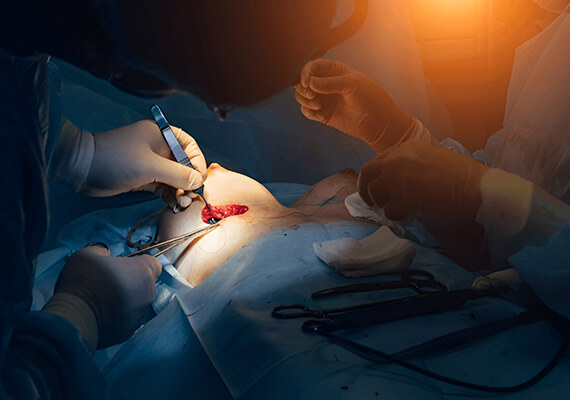
We Provide Very Transparent Pricing To Our Patients !
Breast Reconstruction – 1000 to 15000
Knowledge Centre
For Patient Education







